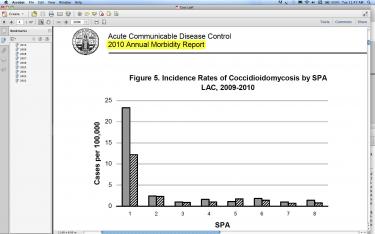![Blowing dust at Antelope Valley Solar Ranch 1 in the Neenach-Fairmont area (Hwy 138 and 170th Street West) began raising concerns last year about Valley Fever exposure. Workers and residents of the area are at increased risk. [Helen Henry photo]
Oso Town Council planned to examine the issue August 30, 6:30 p.m. at Fairmont Market.](https://mountainenterprise.com/fds/images/story/fs_10755.jpg)
Image 1 of 2
Blowing dust at Antelope Valley Solar Ranch 1 in the Neenach-Fairmont area (Hwy 138 and 170th Street West) began raising concerns last year about Valley Fever exposure. Workers and residents of the area are at increased risk. [Helen Henry photo] Oso Town Council planned to examine the issue August 30, 6:30 p.m. at Fairmont Market.
Image 2 of 2
This L.A. Co. Health Dept. chart shows the Antelope Valley service area far exceeds other areas in Valley Fever diagnoses (2010 data).
Is Valley Fever a real threat?
By Patric Hedlund
The Los Angeles County Department of Public Health began mapping animal diagnoses of Valley Fever in 2007. The blowing dust in arid places carries the viral fungal spores of coccidioidomycosis, or “cocci.”
Dogs, cats and humans are all susceptible to the illness; 75% of the pets diagnosed were in the Antelope Valley in 2007.
By 2010, the L.A. County Department of Public Health was publishing graphs showing the average rate of Valley Fever reports per 100,000 of human population was increasing.
“There is no question that Valley Fever spores exist in the Antelope Valley,” says epidemiologist Dr. Dawn Tarashita.
The county average was 2.4 reports per 100,000 people in 2010. But the rate is 23.1 per 100,000 in the Antelope Valley, 10 times higher, and the rate has been increasing. In Kern County, near Bakersfield, the rate is 100 times higher, at 230 per 100,000.
Rural Town Councils in Neenach (Oso Town Council), Fairmont and Antelope Acres have expressed concern that massive dust clouds caused by Antelope Valley Solar Ranch 1 construction activities are increasing Valley Fever risks. So far, the dust abatement treatment success is questionable. AVSR1 was spraying disturbed soil with water and an additive with little success. It is now also using ‘hydromulching’ for suppression.
The data shows another trait of Valley Fever in the Antelope Valley. Unlike other areas in L.A. County, women and younger people are more statistically likely to contract the disease in this area than elsewhere, where older men are most likely to be diagnosed.
"If you can breathe, you can get Valley Fever," is the slogan of the Valley Fever Survivors Association, based in Arizona. They project that there are 98 additional cases of the disease for every two reported by authorities.
This is part of the August 31, 2012 online edition of The Mountain Enterprise.
Have an opinion on this matter? We'd like to hear from you.


